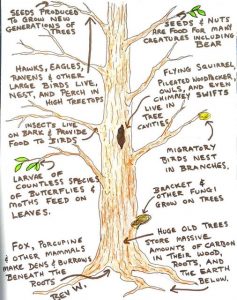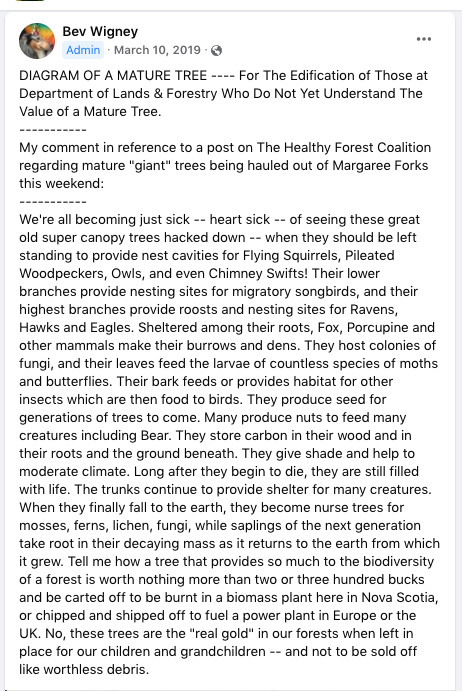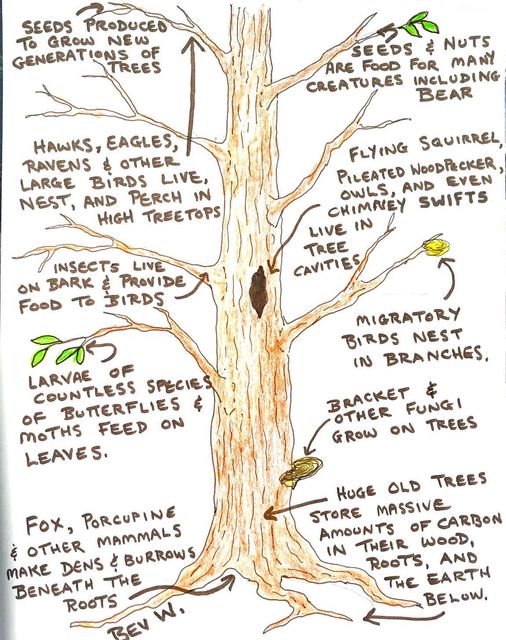My comments:
 Bev Wigney’s sketch of a Mature Tree: there is more than just the tree to value and protect. Read Bev’s description below 1.) Determination of, protection of, and oversight of Old Growth
Forest stands should be removed from the control of the Dept of
Natural Resources and Renewables and moved to the control of the
Department of Environment and Climate Change.
REASON: The DNRR has too much stake in trying to meet the demands of the forest industry. They have failed badly at protecting the forests and the forest ecology that supports flora and fauna in this province. They’ve proven that they are just not up to the task. It’s time to do a big reset on how forests are protected and in moving Old Growth Forest oversight to the Dept of Environment that would, hopefully, be putting it into the hands of those who might have more inclination to value the ecology of Old Growth Forests and not see them as mainly cannon fodder to feed the mills and biomass industry.
2.) The work of discovering, identifying and qualifying Old Growth
Forests should be overseen by a newly created, dedicated committee
consisting of those who understand and value Old Growth Forests as
being critical to protecting and preserving the web of biodiversity.
It should not be left up to a few individuals operating with little
public oversight.
REASON: The forest industry and those within government who champion
the forest industry have too much conflict of interest to be responsible for conservation issues. They covet the very forests that are in greatest need of protection.
Those involved in identification of Old Growth stands should have **no** financial interest in this work. A committee consisting of individuals from a range of backgrounds including: professional foresters, biologists, conservation NGO staff, knowledgeable naturalists, indigenous representatives, etc… should oversee the
designation of Old Growth Forest stands.
If such a system was established, those who know of pockets of Old Growth Forest would not feel that they are consigning a forest to a death sentence by revealing its existence.
At present, no one in their right mind wants to come forward to disclose that kind of information as the forest would immediately be consigned to depredation by the forest industry.
This HAS to change. This needs to be about protection and not just about getting ahold of forests to be chopped down or what little remains of the Old Growth stands will be doomed.
3.) Minimum forest stand size to qualify as a stand should be scaled
down to include even the smallest stands.
REASON: Because we know that some stands have been chopped away at already, making them ineligible to be classed and protected as an Old Growth Forest stand (polygon size being too small). This is especially true of small forest stands where trees were left in the past because they were difficult to harvest. Now, with the new machinery and all of the logging roads being punched through Crown land, some of these remnant forests are fair game.
I am aware of at least one high value stand where this has already occurred. Was this premeditated? That seems quite likely. Should they still be protected? YES.
Even a very small stand of Old Growth Forest can be an incredible repository for biodiversity in what is now becoming a sea of destruction in our Nova Scotia forests.
Small stands, particularly those with pit and mound features, can shelter a vast
network of life, provide vernal pools and other features that can function as a biodiversity oasis in the desert being created by industrial forestry.
4.) Canopy closure percentage as a qualification should be changed
and reduced.
REASON: In a true Old Growth Forest, there can be goodly-sized canopy openings created when a super-canopy tree finally goes down. There are often young shade tolerant trees that are well started and will eventually take that space. To penalize and disqualify a polygon on the basis of not enough canopy closure, causing that stand to be handed off to industrial forestry and chopped down, will result in the unfathomable destruction of biodiversity. Just because there are canopy openings does not mean that there isn’t a huge amount of activity going on in the decaying wood, root systems, duff, thick layers of mosses and lichens.
We have GOT to get away from this fixation on Old Growth Forest being all about trees. IT IS NOT!
5.) Size and age of trees should both be dropped to be more inclusive
of what qualifies as an Old Growth Forest stand. Diversity of species, presence of certain species, presence of fallen, decaying trees, pit and mound, presence of mosses, lichen, fungi, etc.. are just as important. Disqualifying stands on the basis of the lack of “Old” trees is a very faulty criteria.
REASON: We’ve lost too many of our valuable Old Growth forests already. Instead of adjusting downward, it looks like DNRR is now making it even more difficult for some forest types to meet the. criteria for an Old Growth stand. To put it mildly, this is counter to making any progress whatsoever in advancing the state and
protection of Old Growth Forests in this province.
6.) Protection of Old Growth Forests needs to become law rather than
policy.
There need to be stronger regulations concerning destruction of Old Growth stands in the event that this occurs – such as crossing stand boundaries and taking down remnant Old Growth stands that are located beside stands being harvested by industry. The penalties have to be steep enough that this will not occur.
REASON: Because things like this happen and there seem to be little or no repercussions other than a shrug and an “oh, too bad that happened.”
Bev Wigney
Annapolis Royal, NS |



